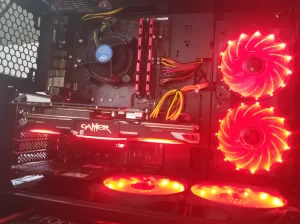80 degrees Celsius is considered a safe temperature for a GPU under heavy load. However, if your GPU is consistently running at this temperature, it may be worth investigating methods to improve cooling within your system to ensure the longevity of your hardware.
Understanding GPU Temperatures

Just like any piece of hardware in your computer, your GPU (Graphics Processing Unit) generates heat as it operates. It’s a by-product of the intense calculations it performs in order to render graphics. The temperature at which your GPU operates is a significant indicator of its performance and health.
Temperature metrics for GPUs vary from model to model, brand to brand. However, they all share the same fundamental principle: lower is generally better, but there is an optimal temperature range for operation. This optimal range ensures that the GPU performs at its best without causing any potential damage. Most modern GPUs can handle temperatures up to 90-100C, but it’s typically recommended to keep the temperature below 85C.
Monitoring your GPU’s temperature is crucial for several reasons. A continually overheated GPU may suffer from reduced performance, a shortened lifespan, and in extreme cases, permanent damage. It can also cause your system to crash or become unstable. Hence, keeping an eye on your GPU’s temperature can help you prevent these issues.
So, what is considered a normal GPU temperature? For most gaming setups, a temperature of 60-70C under load is a good target to aim for. Idle temperatures, when the GPU is not being used heavily, should generally be under 60C. However, these values might vary based on the specific model of the GPU, the cooling solutions used, and the overall ambient temperature in the system.
Is 80℃ Normal for a GPU?
Operating temperatures for GPUs can vary greatly depending on the specific model, cooling solutions, and workloads. 80℃ might be a normal temperature for some GPUs and might indicate an issue for others.
GPUs can reach 80C under several circumstances. For example, during heavy workload periods such as extended gaming sessions or intensive graphic design tasks. High ambient temperature in your PC case, poor ventilation, or inadequate cooling solutions might also lead to increased GPU temperatures.
So what does it mean for a GPU to be operating at 80℃? As noted earlier, this isn’t necessarily a problem, but it’s toward the high end of the preferred operating temperature range for most GPUs. Over time, consistent operation at this temperature may result in reduced performance and a shorter lifespan for the GPU due to increased wear and tear.
While 80C can be normal under certain circumstances, it’s important to monitor your GPU temperatures consistently. If your GPU regularly hits or exceeds this temperature under a standard load, it might be an indication that you need to improve your PC’s cooling system or adjust your GPU’s settings. Some modern GPUs have built-in features that can help regulate temperature, like automatic fan speed adjustments or even throttling the performance to reduce heat.
Is 80℃ Good While Gaming?
In gaming, the GPU (Graphics Processing Unit) is the star of the show. It’s the hardware that’s primarily responsible for rendering the stunning graphics and smooth animations that take your gaming experience to the next level. However, this intense work generates heat, and the more demanding the game, the hotter your GPU can get.
As previously discussed, a GPU running at 80℃ isn’t necessarily alarming, but it’s higher than the ideal range for most GPUs. When gaming, your GPU is under a significant workload, and it’s normal for the temperature to rise. Games with high-resolution textures, complex environments, or high frame rates will push your GPU harder, resulting in increased temperatures.
While gaming, if your GPU temperatures are regularly reaching 80℃, it might be time to consider implementing some cooling solutions. This could include adding more or better quality fans to your system, improving the airflow in your PC case, using a GPU with a better cooling design, or even considering a more advanced solution like liquid cooling.
You may also like: Will Gaming with a 90°C CPU Cause Damage to Your PC?
Frequently Asked Questions
Is 85℃ safe for a GPU?
Although a GPU can function at 85C, it’s generally considered a high temperature. Extended usage at this temperature can potentially lead to damage or reduced lifespan of the GPU. It’s recommended to aim for lower temperatures where possible, and consider additional cooling measures if your GPU often reaches this temperature.
Is 90℃ safe for a GPU?
90C is a very high temperature for a GPU and can be potentially dangerous. Prolonged exposure to this temperature can decrease the longevity of your GPU and may lead to system instability or damage. Immediate cooling solutions should be considered if your GPU consistently hits this temperature.
Is 59℃ good for a GPU?
Yes, 59C is a safe and good temperature for a GPU under load. It indicates that the GPU cooling solutions are working effectively. This temperature is well within the safe range and should not affect the GPU’s performance or longevity.
Is 80 degrees safe for an RTX 3060?
While the RTX 3060 can operate at 80 degrees, it’s near the upper end of the desired temperature range. Running at this temperature regularly could potentially shorten the lifespan of the GPU. If your RTX 3060 consistently runs at this temperature, it might be worth looking into additional cooling solutions to bring the temperature down.
